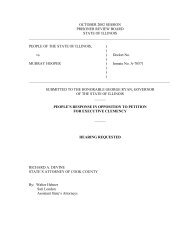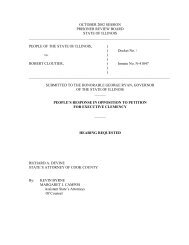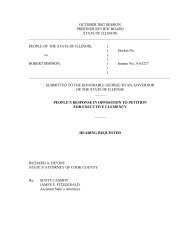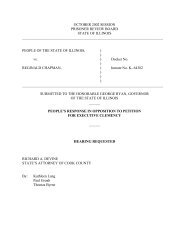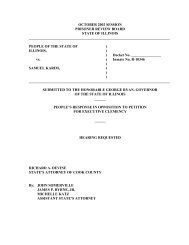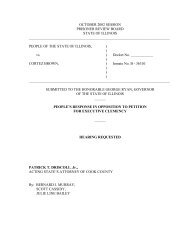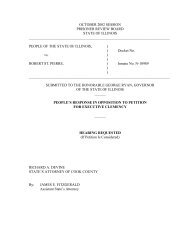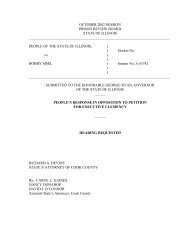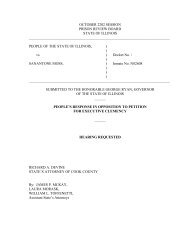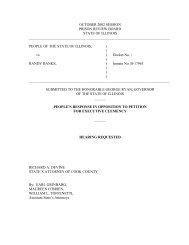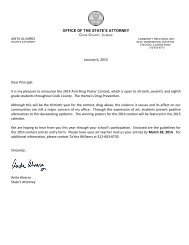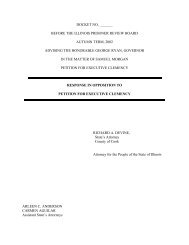Ronald Kliner - Cook County State's Attorney
Ronald Kliner - Cook County State's Attorney
Ronald Kliner - Cook County State's Attorney
You also want an ePaper? Increase the reach of your titles
YUMPU automatically turns print PDFs into web optimized ePapers that Google loves.
OCTOBER 2002 SESSION<br />
PRISON REVIEW BOARD<br />
STATE OF ILLINOIS<br />
______________________________________________________________________________<br />
PEOPLE OF THE STATE OF ILLINOIS )<br />
) Docket No.<br />
vs. )<br />
)<br />
RONALD KLINER ) Inmate No. B77152<br />
)<br />
)<br />
_________________________________________________________________________________<br />
I.<br />
HISTORY OF THE CASE<br />
Petitioner, <strong>Ronald</strong> <strong>Kliner</strong>, shot Dana Rinaldi five times in the face killing her as she was<br />
exiting her car in front of her home. He shot her pursuant to a contract for hire with the<br />
victim’s husband Joseph Rinaldi. Another co-conspirator, Michael Permanian, was also<br />
present at the murder scene.<br />
Petitioner pled not guilty and Michael Permanian and he were tried simultaneously to<br />
separate juries for two counts of first degree murder under Ill. Rev. Stat. (1987) ch. 38, para.<br />
9-1(a)(1) and (a)(2) and one count of conspiracy to commit first degree murder in violation of<br />
Ill. Rev. Stat. (1987) ch. 38, para. 8-2. Both <strong>Ronald</strong> <strong>Kliner</strong> and Michael Permanian were found<br />
guilty<br />
by each of their juries on all counts.<br />
1
<strong>Ronald</strong> <strong>Kliner</strong> elected a bench sentencing hearing conducted by Judge Janice Bierman.<br />
The judge sentenced <strong>Ronald</strong> <strong>Kliner</strong> to death.<br />
The Illinois Supreme Court considered <strong>Kliner</strong>’s appeal and affirmed both his conviction and<br />
sentence of death in People v. <strong>Kliner</strong>, 185 Ill.2d 81 (1998). The Illinois Supreme Court subsequently<br />
denied a defense motion for a rehearing. In July, 1998 <strong>Ronald</strong> <strong>Kliner</strong> applied for clemency. A hearing<br />
was held and clemency was denied. In October, 2000 he again applied for clemency and a hearing<br />
was held. That matter is still pending.<br />
In addition, several post conviction proceedings have been heard and denied. An issue<br />
in the last post conviction proceeding is still pending.<br />
II<br />
2
FACTS OF THE CASE<br />
Petitioner, <strong>Ronald</strong> <strong>Kliner</strong>, was indicted by the Grand Jury on two counts of first degree<br />
murder and one count of conspiracy. Petitioner pled not guilty. A jury convicted petitioner on<br />
all counts. Judge Janice Bierman found petitioner eligible for the death penalty under the<br />
murder for hire provision. At the conclusion of the hearing on aggravation and mitigation,<br />
Judge Bierman found no factors sufficient to preclude the death penalty, and she sentenced<br />
petitioner to death.<br />
During the trial, statements made by petitioner and co-defendant Permanian to<br />
witnesses called at trial detailed the events of the night of the murder. Shortly after midnight<br />
of February 18, 1988, Dana Rinaldi was shot five times in face by <strong>Ronald</strong> <strong>Kliner</strong> as she was<br />
exiting her car to go to her apartment. He and Michael Permanian had entered the complex<br />
where she lived and waited for her to return home from work. When Permanian got “cold<br />
feet” <strong>Kliner</strong> walked up to Dana’s car as she was getting out. She said, “What are you doing?”<br />
and put her hand and purse in front of her face in self defense as <strong>Kliner</strong> pointed the gun at her<br />
face. The first round jammed; he ejected it. Then laughing as he looked the terrified<br />
expression on Dana’s face, <strong>Kliner</strong> shot her five times in the face.<br />
This was the result of a murder for hire. Dana’s husband, Joe Rinaldi, hired Michael<br />
Permanian, the best man at his wedding, and <strong>Ronald</strong> <strong>Kliner</strong>, whom he knew since he was 12<br />
years old, to kill his wife for half the proceeds of a $50,000 life insurance policy. At first the<br />
discussions were between Permanian and Joe Rinaldi. Around Thanksgiving, 1987 Permanian<br />
suggested they meet with <strong>Kliner</strong> who might be able to help him. In December, they met about<br />
three times. <strong>Kliner</strong> showed Joe Rinaldi a gun in is waistband and asked questions about<br />
3
Dana’s lifestyle and her work hours. Joe Rinaldi drew them a map of the apartment complex<br />
on a napkin and they agreed that it was a good place to do the job.<br />
On February 15, 1988, they met again and decided to do the job on February 17.<br />
<strong>Kliner</strong> and Permanian would steal a car, Joe Rinaldi would arrange for an alibi and go out for<br />
that evening, and they would page him when the job was finished.<br />
Rinaldi arranged to go out bar hopping with a friend, Jim Gruska, and he did not<br />
return home until well after midnight, February 18, 1988. He knew the murder had been<br />
carried out when he returned home and saw his wife’s car being towed away. He had<br />
practiced crying so as to appear to be grief stricken to the police.<br />
When Rinaldi called him later that day in accordance with his instructions, Permanian asked<br />
how Rinaldi had fared with the officers. Rinaldi admitted he had told the police about Permanian’s<br />
car. Permanian then asked “why the hell did you tell them about my car”, and he admitted that “he<br />
and Ron used his [Permanian’s] car” instead of stealing one.<br />
Rinaldi also met Permanian at a restaurant on February 29, when Permanian instructed<br />
Rinaldi not to say anything to the police. Permanian told Rinaldi that he would “end up like she did” if<br />
he did not “keep his fucking mouth shut”. Around March 2, Permanian asked Rinaldi what he had<br />
told the authorities. Permanian again told him “you know what will happen” if he talked to the police.<br />
Rinaldi eventually received $51,767 from Metropolitan Life as well as $83,000 from<br />
Dana’s employer’s policy with Traveler’s Insurance. There was a pension of $3,000 that he<br />
also received. Rinaldi originally agreed to pay Permanian and <strong>Kliner</strong> $25,000 each, and he did not<br />
immediately disclose the Traveler’s policy to Permanian and <strong>Kliner</strong>.<br />
The payments began in late March of 1988, when Rinaldi met Permanian at a restaurant and<br />
passed him $400 under the table. After Permanian demanded $500 a week to be shared with <strong>Kliner</strong><br />
4
until the insurance money came through, Rinaldi started making regular $300 to $500 payments to<br />
Permanian. Rinaldi made payments, usually on a weekly basis, until November of that year.<br />
But Rinaldi frequently experienced problems meeting his obligations. In June, Rinaldi asked<br />
Permanian to suspend his payments because he could not meet his own expenses. Permanian said he<br />
and <strong>Kliner</strong> would kill him if he stopped paying.<br />
In November, Permanian contacted Rinaldi and told him that he and “Ron” knew about the<br />
extra policy. Permanian stated Rinaldi would “end up dead like she did” if Rinaldi “fucked around”<br />
with his payments. Permanian claimed Rinaldi now owed them $65,000, but he eventually agreed to<br />
accept $55,000 instead. Permanian urged Rinaldi to increase his weekly payments from $500 to $1,000.<br />
Permanian cautioned there was nothing he could do about <strong>Kliner</strong>’s share, however, and added that<br />
<strong>Kliner</strong> was very anxious to get paid. Rinaldi accordingly increased his weekly payments to $1,000.<br />
Late in March of 1989, Permanian called Rinaldi and demanded $2,000 “juice money” until he<br />
was paid in full. He threatened to kill Rinaldi if he refused.<br />
In April of 1989, Rinaldi met both Permanian and <strong>Kliner</strong> in an alley behind an Elmwood Park<br />
restaurant. Permanian looked at <strong>Kliner</strong>, pointed at Rinaldi, and said “look who is here”. <strong>Kliner</strong> then<br />
demanded his money and reminded Rinaldi that he had assured him they would “get away with it”.<br />
Rinaldi gave Permanian $1,000 which Permanian handed to <strong>Kliner</strong> saying, “Here, Ron, this thousand<br />
dollars is yours. I got $500 extra last time. And besides, it was your gun.”<br />
Early in August of 1989, Permanian called Rinaldi again. Permanian said that <strong>Kliner</strong><br />
would kill him if did not receive his [<strong>Kliner</strong>’s] money by the end of the month. But Rinaldi<br />
persuaded Permanian to talk to <strong>Kliner</strong>. Five or six days later, Rinaldi met Permanian at the<br />
fire station where Permanian worked. Permanian again threatened him and claimed <strong>Kliner</strong><br />
would kill him if he didn’t receive his money by the end of the month. By this point, Rinaldi<br />
had already paid the men $35,000, and Permanian agreed to try to arrange some sort of<br />
5
payment plan for the balance.<br />
On August 19 or 20, 1989, Permanian paged Rinaldi and they met at a restaurant.<br />
Permanian told him he must come up with $19,000 by the end of the month, from which <strong>Kliner</strong><br />
would be paid $17,000. Permanian said they could resume their regular payment schedule<br />
after <strong>Kliner</strong> was paid. . Rinaldi paid Permanian $19,000 late in August of 1989.<br />
No arrests were made in this case until June 10, 1993, when three important witnesses<br />
came forward. The first of these was Joseph Rinaldi, the victim’s husband, who later testified<br />
for the State in exchange for the prosecutor’s promise to recommended a 40 year sentence and<br />
seek exemplary “good time” credits for work and school. The State also placed him in the<br />
witness protection program and agreed to recommend he not be prosecuted for tax evasion.<br />
The other two were, Tammy Behenna, <strong>Ronald</strong> <strong>Kliner</strong>’s girlfriend and mother of their<br />
son, and his uncle John Apel, Sr. <strong>Kliner</strong> bragged to them on numerous occasions about the<br />
murder and demonstrated to them how it occurred. Both were terrified of him and feared for<br />
their lives if they ever disclosed what he had revealed to them. <strong>Kliner</strong> reinforced their fears<br />
with numerous threats on their lives. In the case of his uncle, a Chicago Police Officer, he also<br />
threatened to kill his son and daughter.<br />
<strong>Kliner</strong> was tried by a jury for two counts of first degree murder under Ill. Rev. Stat.<br />
(1987) ch. 38, para. 9-1(a)(1) and (a)(2) and one count of conspiracy to commit first degree<br />
murder in violation of Ill. Rev. Stat. (1987) ch. 38, para. 8-2. On January 23, 1996 the jury<br />
trial commenced. <strong>Ronald</strong> <strong>Kliner</strong> was found guilty of the February 18, 1988 shooting death of<br />
Dana Rinaldi in Palatine, Illinois by the jury on February 28, 1996. In a separate jury trial<br />
proceeding simultaneously, the co-defendant, Michael Permanian, was also convicted of the<br />
6
same charges.<br />
On May 7, 1996 the began a hearing on aggravation and mitigation. <strong>Ronald</strong> <strong>Kliner</strong><br />
elected a bench sentencing hearing conducted by Judge Janice Bierman. After the State<br />
proved <strong>Kliner</strong>’s age, and the judge took judicial notice of the verdicts and the trial testimony<br />
in this case, the judge found <strong>Kliner</strong> eligible for the death penalty under Ill. Rev. Stat. (1987) ch.<br />
38, para. 9-1(B)(5), murder committed pursuant to a contract.<br />
A lengthy aggravation and mitigation proceeding followed immediately which ended on<br />
May 15, 1996. The evidence in aggravation heard and considered by the judge is outlined<br />
below.<br />
RONALD KLINER’ CRIMINAL CONDUCT<br />
<strong>Ronald</strong> <strong>Kliner</strong>’s “rap sheet” shows approximately 16 arrests, but few convictions,<br />
because approximately 10 charges were SOL-ed in court. Before his convictions in this case,<br />
<strong>Kliner</strong> had been convicted of aggravated battery, aggravated unlawful restraint, and 2 counts<br />
of unlawful use of weapons.<br />
<strong>Kliner</strong> also had been found in contempt of court after a<br />
courtroom outburst in another case. In 1982, <strong>Ronald</strong> <strong>Kliner</strong> gave his uncle, John Apel, Sr. a<br />
copy of his mug shot claiming he had his record “taken care of.”<br />
<strong>Kliner</strong> kept a scrapbook of newspaper clippings describing crimes that he had<br />
committed. Shortly after each crime, <strong>Kliner</strong> gave his uncle, John Apel Sr., a clipping about the<br />
crime and told him to place it in the “family archives.” Some of the clippings were lost when<br />
Apel’s home was burglarized. Someone stole gold coins, jewelry, Apel’s police star, and his<br />
police snub-nose revolver. Apel always believed that <strong>Kliner</strong> had committed the burglary, and<br />
7
he filed a police report to that effect. On three to four occasions, he reported <strong>Kliner</strong>’s<br />
activities to his supervising officer at the Chicago Police Department, filed written reports, and<br />
recommended that criminal charges be filed against his nephew.<br />
BURGLARIES<br />
<strong>Ronald</strong> <strong>Kliner</strong> gave his uncle a newspaper article dated October 24, 1979 describing<br />
the burglary of a Kush gas station on West Grand Avenue in which thieves stole car repair<br />
equipment and several vehicles. After a juvenile arrested in one of the stolen cars implicated<br />
him, officers arrested <strong>Kliner</strong> and recovered a battery charger and tools taken in the burglary<br />
from him. Apel filed an information report about this incident, too.<br />
On December 17, 1980, Chicago police officer Harry Collins set up a surveillance of<br />
<strong>Kliner</strong>’s home. <strong>Kliner</strong> was a suspect in a burglary of a Sears store in the Golf Mill Shopping<br />
Center in Niles, Illinois earlier that day in which $70,000 worth of watches, gold chains and<br />
coins had been taken. Collins watched while <strong>Kliner</strong> and a companion arrived at <strong>Kliner</strong>’s<br />
home. They soon drove away, however, and Collins followed them for awhile before losing<br />
<strong>Kliner</strong> in traffic.<br />
When Collins managed to stop the other man, Michael Marecki, Collins found three<br />
watches with Sears tags in Marecki’s possession. Marecki said he had bought the watches from<br />
<strong>Kliner</strong>.<br />
<strong>Kliner</strong> surrendered to the police the next day and admitted the burglary. <strong>Kliner</strong> said he<br />
had hidden in a washroom for more than 6 hours until the store closed. He then took<br />
sledgehammers, crowbars and other tools from the tool department to loot cases in the jewelry<br />
and coin departments before stealing tote bags from the luggage department in which to carry<br />
8
the loot.<br />
After <strong>Kliner</strong> told the officers that he had hidden some of the stolen merchandise in his<br />
mother’s home in Indiana, officers visited the home and recovered 80 gold watches, 400 gold<br />
chains, 460 silver coins, 58 coin sets, and a quantity of silver bars which were identified by a<br />
Sears employee. <strong>Kliner</strong> was acquitted after his attorney filed a successful motion to suppress.<br />
<strong>Kliner</strong> was also a suspect in the July 31 burglary of the Sears store on Harlem Avenue<br />
in which $200,000 worth of watches, gold chains and coins were stolen. Once again, thieves hid<br />
in the store and used tools from the hardware department to loot the jewelry and coin<br />
departments. Rinaldi corroborated this evidence when he testified that Permanian told him<br />
about the burglary of a Sears store at North Avenue and Harlem. Police officers found a<br />
number of keys taken in burglaries on the northwest side in <strong>Kliner</strong>’s home.<br />
Charles Kundrot and other police officers at approximately 2:30 a.m. on March 11,<br />
1981, responded to an ADT alarm and saw <strong>Kliner</strong> and Peter Pulice running up an escalator in<br />
the Carson, Pirie, Scott store at the Yorktown Shopping Center in Lombard, Illinois. The<br />
officers gave chase and eventually caught <strong>Kliner</strong> hiding under a clothes rack. <strong>Kliner</strong> offered to<br />
give the officers $10,000 and a bag of jewelry in his possession if they would not charge him.<br />
The officers found that the men had entered through a skylight in the roof, had taken knives<br />
from the housewares department, and had broken into display cases in the jewelry<br />
department. The officers recovered a bag containing $100,000 to $113,000 worth of gold<br />
jewelry.<br />
John Apel accompanied <strong>Kliner</strong> and his attorney, Dean Wolfson, when <strong>Kliner</strong> appeared<br />
in court before Judge Reynolds on those burglary and bribery charges. <strong>Kliner</strong> told Apel “not<br />
9
to worry,” adding that it had cost him $13,000 to make sure the case was “taken care of.” The<br />
charges were dismissed after Judge Reynolds granted <strong>Kliner</strong>’s motion to suppress.<br />
<strong>Ronald</strong> <strong>Kliner</strong> gave John Apel, Sr. newspaper articles detailing two additional<br />
burglaries. One described December, 1981 burglary of the McDade and Co. store in Niles in<br />
which someone cut a hole in the roof, climbed down an electrical cord, and stole $100,000<br />
worth of jewelry, mostly watches. Once again, no attempt was made to steal diamonds stored<br />
in a safe. The article refers to a “tiny burglar” because the burglar managed to crawl through<br />
a 12 inch by 14 inch hole. (<strong>Kliner</strong> is 5'3" to 5'5" and weighs about 140 pounds). The other<br />
describes a burglary of the Carson, Pirie Scott store in Mt. Prospect in which someone broke a<br />
window to enter the store and steal $85,000 in jewelry and gold watches. Once again, <strong>Kliner</strong><br />
told Apel to keep the articles “for the family archives.”<br />
According to Joe Rinaldi, Permanian also bragged about a burglary he and <strong>Kliner</strong> had<br />
committed late in 1981 or early 1982, when they burglarized the Sears store at the Woodfield<br />
Mall and took a quantity of jewelry.<br />
Police officer Eric Bjankini was called to the Western Savings Bank in Glenview on<br />
August 6, 1984 to investigate a burglary committed over the weekend. After using a key to<br />
enter the bank and deactivate the alarm, someone had stolen $15,000 from the bank. <strong>Kliner</strong><br />
had been employed by the bank, but he had been fired the previous Friday. Even though he<br />
had been issued only one key to the bank, <strong>Kliner</strong> surrendered two keys at that time. <strong>Kliner</strong><br />
had told Joe Rinaldi that Permanian and he had burgled the bank where <strong>Kliner</strong> worked, that<br />
they had done so the day before, and that they were on their way to Las Vegas to celebrate.<br />
<strong>Kliner</strong> called John Apel, Sr. on August 6, 1984 to report he had lost his job at the bank. <strong>Kliner</strong><br />
10
told Apel he was with Permanian in a hot tub in Las Vegas, partying with a couple of<br />
prostitutes and a pile of cocaine.<br />
ASSAULTS AND BATTERIES: “ROAD RAGE” INCIDENTS<br />
As Michael Scornavacco was returning home from work on January 7, 1987, he saw a<br />
car traveling east on Grand Avenue. As Scornavacco watched, the car crossed two lanes of<br />
traffic, drove across the center line, and struck pedestrian Philip Teretilli as he tried to cross<br />
the street. Teretilli later died.<br />
Scornavacco saw the car accelerate and drive away, and he pursued the car as long as<br />
he could. The car traveled at a high rate of speed against oncoming traffic, running red lights.<br />
Scornavacco thought the offender was a white male in his 20's, maybe Hispanic, who had a<br />
mustache.<br />
<strong>Kliner</strong> later claimed responsibility for the murder and mentioned it to Tammy Behenna<br />
several times. <strong>Kliner</strong> asked her if she had ever seen someone’s face pressed against a<br />
windshield. He also ordered Tammy to cross the street and told her to be careful, “you know<br />
what happens,” he threatened her.<br />
On the afternoon of February 25, 1987, Bradley Slager was driving through River<br />
Grove when a car cut in front of him. Slager testified that he waved his hands as if to say,<br />
“what’s this all about?” A man, later identified as <strong>Kliner</strong>, ran out of his car and struck<br />
Slager’s car with a revolver.<br />
Slager believed <strong>Kliner</strong> was a police officer because he was wearing a shirt that had a<br />
police badge on it. Slager also said that spit was coming out of <strong>Kliner</strong>’s mouth while <strong>Kliner</strong><br />
screamed, “You don’t know who I am. I do this for a living.” Slager locked the doors and<br />
11
managed to drive away.<br />
Slager drove straight to the police department and gave them the license number. He<br />
later identified <strong>Kliner</strong> in a photograph array. <strong>Kliner</strong> told police officers that he had squirted<br />
Slager with a plastic gun. At the death sentencing hearing in front of Judge Bierman, Slager<br />
again identified <strong>Kliner</strong> while <strong>Kliner</strong> was waving his hand and saying, “does this help?”<br />
On March 2, 1987, while Officer Gerald Rutkowski was issuing a traffic citation to<br />
David Mosdale, a man got out of his car, crouched down, and fired what was believed to be a<br />
.38 snub-nosed revolver at the officer. The assailant then hollered something about “cops” and<br />
drove away. After Mosdale gave a plate number to the police, they traced the number and<br />
arrested <strong>Kliner</strong>, Mosdale identified <strong>Kliner</strong> in a lineup conducted at police headquarters.<br />
<strong>Kliner</strong> had a different interpretation of the incident. He said that he had a traffic<br />
altercation with a motorist and had fired a cap gun just to scare him. He then threw the cap<br />
gun away because he was afraid he might be arrested. <strong>Kliner</strong> gave his uncle a newspaper<br />
article regarding this incident to keep for the family archives. <strong>Kliner</strong> was later acquitted of<br />
aggravated assault. When he appeared in court, officers arrested <strong>Kliner</strong> for bringing a .25<br />
automatic starter gun into court to use as evidence.<br />
On the afternoon of January 28, 1988, seventeen year old Andrew McIntosh and two<br />
friends were driving on Belmont Avenue when a car cut him off. The driver “gave him the<br />
finger” and McIntosh responded in kind. As McIntosh passed the car, he could see someone<br />
holding a gun up to the window. It did not appear to be a cap gun or starter pistol. McIntosh<br />
drove as fast as he could to get away, but the car followed him and eventually cut in front of<br />
him, wedging him in traffic.<br />
12
The passenger, subsequently identified in open court at the death sentencing hearing as<br />
<strong>Kliner</strong>, got out and walked to the passenger side of McIntosh’s car. <strong>Kliner</strong> smacked the butt of<br />
a gun against the window and kicked the door. <strong>Kliner</strong> then walked to the driver’s side of the<br />
car. After McIntosh unsuccessfully tried to close the automatic windows of the car, <strong>Kliner</strong><br />
grabbed him by the back of the head and pulled him down. In McIntosh’s words, “and it’s a<br />
gun stuck up here into my face and eye and on my cheek going around my mouth ... and this<br />
guy is screaming things at me.” <strong>Kliner</strong> said “I will kill you for free; I have killed pieces of shit<br />
like you for two dollars. Fucking scum bag.”<br />
McIntosh began to pray. He then heard the gun hit the window frame and heard a<br />
clicking noise. After <strong>Kliner</strong> walked back to his car, McIntosh drove away. He then went to the<br />
police station and reported <strong>Kliner</strong>’s license number. He never went to court.<br />
On February 17, 1988, Victor Francisco was driving his pickup truck on Harlem<br />
Avenue when a car cut in front of him. Francisco identified <strong>Kliner</strong> in open court and said he<br />
was the driver of that car.<br />
When Francisco asked him what he was doing, <strong>Kliner</strong> answered, “what the fuck is your<br />
problem,” and he pulled a gun from the waistband of his pants. <strong>Kliner</strong> then pointed the gun at<br />
Francisco’s face and said, “Do you want me to fucking shoot you? What is your fucking<br />
problem?” Just before the light changed, <strong>Kliner</strong> also said he would, “shoot your fucking ass<br />
for free.” Francisco heard a gunshot.<br />
As Francisco followed <strong>Kliner</strong>, he saw <strong>Kliner</strong> drive southbound, against the flow of<br />
traffic, in the northbound lanes of the highway during rush hour traffic. Francisco recorded<br />
the license plate number and made a police report. Francisco later saw <strong>Kliner</strong> again at police<br />
13
headquarters, where <strong>Kliner</strong> apologized for shooting his truck.<br />
When he arrested <strong>Kliner</strong> at 2:00 a.m. on February 19, Officer Joseph Cucciera<br />
recovered a .380 semi-automatic with clips and extra clips from <strong>Kliner</strong>’s person and a loaded<br />
police riot shotgun with extra ammunition in the trunk. Cucciera also found a knife with a 5"<br />
blade on the front seat after ordering the passengers from the car.<br />
Francisco filed charges. Francisco saw <strong>Kliner</strong> with a police officer in an elevator after<br />
one of his court appearances. <strong>Kliner</strong> said, “Why don’t you knock this fucking shit off; when<br />
are you going to give this bull shit up?” <strong>Kliner</strong> was later convicted and received a conditional<br />
discharge sentence.<br />
This incident took place approximately six hours before Dana Rinaldi was murdered.<br />
On the evening of October 7, 1991, Michael Budnick was driving down Cumberland<br />
Avenue with his passengers, John Schillace and Matt Howard, when <strong>Kliner</strong> and Permanian<br />
began to chase them. After <strong>Kliner</strong> managed to get in front of Budnick and cut him off, both<br />
<strong>Kliner</strong> and Permanian got out of their car.<br />
<strong>Kliner</strong> threw a flashlight through a window which broke the window, hit Budnick in the<br />
arm, and landed in the back seat of Budnick’s car. At this point, Schillace remembers that<br />
<strong>Kliner</strong> said “I’m a cop, get down on the ground.” According to Budnick, in turn, <strong>Kliner</strong> said<br />
he was a police officer, reached inside the car, pulled him out of the car, and struck him.<br />
Permanian then threw Schillace to the ground and kicked him. <strong>Kliner</strong> was arrested after<br />
police officers at a nearby McDonald’s noticed the incident and came to their aid.<br />
Two weeks later, officers contacted Schillace and Budnick and advised them that <strong>Kliner</strong><br />
wished to settle out of court. Schillace and Budnick met <strong>Kliner</strong> and Permanian at a Denny’s<br />
14
estaurant. <strong>Kliner</strong> gave him a $250 check, Schillace signed something, and he agreed not to go<br />
to court. At that point, Permanian said “I guess I can put the gun away now.” At the<br />
sentencing hearing in aggravation in front of Judge Bierman, while Schillace was testifying,<br />
Judge Bierman had to admonish <strong>Kliner</strong> to refrain from laughing or engaging in any further<br />
outbursts. While Budnick was testifying regarding being beaten by Permanian, <strong>Kliner</strong> said,<br />
“I beat you. He didn’t.” <strong>Kliner</strong> also waved and said “it’s me.”<br />
ARSONS<br />
Carol Heiman knew <strong>Kliner</strong> when they were students at Northeastern Illinois<br />
University. They did not get along well because Heiman, a staff writer for the school<br />
newspaper, wrote articles criticizing expenditures made by the student government. <strong>Kliner</strong><br />
was a Student Senator at the time. On March 3, 1983, <strong>Kliner</strong> said he was going to “teach” her<br />
and “get” her if she “fucked with him.”<br />
During the first week of March, Heiman filed a complaint against <strong>Kliner</strong> in the<br />
University Court; she reported <strong>Kliner</strong> had already threatened four times to “get” her if she<br />
continued to write critical articles.<br />
On March 17 at 2:40 a.m., someone threw a pipe bomb at the front door of her parents’<br />
home, causing considerable damage. Heiman testified it could not have been a firecracker,<br />
and a police officer found a cardboard tube and brown paper likely used as a wick for an<br />
explosive powder. A week later, Heiman’s tires were slashed, as well.<br />
David Doehler was another fellow student who did not get along with <strong>Kliner</strong>, and his<br />
home was fire-bombed, also, at 2:30 a.m. that same night. The front porch, door and entrance<br />
way were damaged, and officers again found a paper tube at the scene. <strong>Kliner</strong> knew where he<br />
15
lived because he had been to Doehler’s home.<br />
Doehler had argued with <strong>Kliner</strong> in January, when <strong>Kliner</strong> said he could make a phone<br />
call and break both his fucking legs. Then, three days before the arson, <strong>Kliner</strong> threatened to<br />
“get him”. Doehler later told <strong>Kliner</strong> he knew he was responsible. <strong>Kliner</strong> taunted, “Yeh, but<br />
you can’t prove it”.<br />
Within five minutes of the bombing, police officer Zelasco stopped a car at the entrance<br />
to the cul-de-sac where Doehler lived. The men fled when Zelasco approached, but after<br />
chasing them he was able to determine that <strong>Kliner</strong> was a passenger in a car driven by<br />
Permanian.<br />
THREATS TO TAMMY BEHENNA AND HER FAMILY<br />
On the afternoon of August 12, 1991, Schaumberg police officer Michael Carroll was<br />
sent to the home of Tammy Behenna and her parents. <strong>Kliner</strong> was present when he arrived.<br />
Tammy reported that when she had refused to allow <strong>Kliner</strong> to enter the home, <strong>Kliner</strong> kicked<br />
and pounded on the door and tried to gain entry. Tammy added that she had problems with<br />
<strong>Kliner</strong> in the past, and that <strong>Kliner</strong> had been “keeping a watch” on her. Carroll arrested<br />
<strong>Kliner</strong> for criminal trespass, but the court later dismissed the charge. During an inventory<br />
search of <strong>Kliner</strong>’s car, officers found a set of metal knuckles under the seat.<br />
Tammy moved in with Donald Cullimore, her step father, and his wife after <strong>Kliner</strong><br />
pistol-whipped Tammy on July 1, 1991. <strong>Kliner</strong> also harassed Tammy with telephone calls. He<br />
called her family more than 100 times after she left him, and he used vulgar language on at<br />
least 30 occasions. Cullimore filed a telephone harassment charge.<br />
On July 14, 1991 <strong>Kliner</strong> came to see Tammy and his son but became verbally abusive.<br />
16
Cullimore called <strong>Kliner</strong>’s supervisor at the forest preserve.<br />
On August 12, 1991, Tammy called Cullimore and reported <strong>Kliner</strong> was pounding on the<br />
doors and windows, as described above; Cullimore told her to call the police.<br />
On March 31, 1992, <strong>Kliner</strong> called and said, “you son of a bitch; suck my cock; this ain’t<br />
the last you heard of me. It ain’t over yet.” <strong>Kliner</strong> kept his word; in Donald Cullimore’s<br />
words, “he harassed us forever.”<br />
Finally, when <strong>Kliner</strong> visited them in July or August of 1991, Cullimore grabbed <strong>Kliner</strong><br />
by the collar and told him to stay away. <strong>Kliner</strong> said, “You’re lucky. I’ll get you,” and left.<br />
Cullimore saw a gun on the seat of <strong>Kliner</strong>’s car at that time.<br />
OTHER THREATS<br />
<strong>Attorney</strong> Terry Ekl represented <strong>Kliner</strong> on two cases in 1993. He had also represented<br />
<strong>Kliner</strong> in ten cases in the past. Ekl and <strong>Kliner</strong> argued after, based on his investigation of the<br />
cases, Ekl recommended a guilty plea. Ekl was allowed to withdraw from those cases,<br />
however, after <strong>Kliner</strong> threatened to kill him and his family on March 6, 1993.<br />
After he was assigned to investigate the Heiman incident, Skokie police officer Richard<br />
Stuebe contacted Sgt. Holt of the Northeastern campus police. Holt had three reports on file,<br />
including a 1981 trespass, a 1982 assault in which <strong>Kliner</strong> cursed at a telephone repairman, and<br />
the Heiman incident.<br />
Stuebe then contacted Walter Williams, the director of student services at Northeastern<br />
University. Williams said he’d received many reports of <strong>Kliner</strong> threatening others. Williams<br />
himself once heard <strong>Kliner</strong> say he liked using a .357 to “blow people’s heads off.” On another<br />
17
occasion, when Williams remarked that criminals sometimes end up dead, <strong>Kliner</strong> replied that<br />
anyone who “got” him would end up meeting him at the “pearly gates.”<br />
Stuebe also contacted Gordon Mihajlovic, who reported that someone had burgled his<br />
parents’ home after he argued with <strong>Kliner</strong> over student government matters.<br />
Northeastern Public Safety officer Robert Zuley told Stuebe that <strong>Kliner</strong> had threatened<br />
to “cause gas to rain down upon people’s houses and cars.” Zuley also recalled that <strong>Kliner</strong><br />
claimed he had already done so to the business of a man who had “fucked with him.”<br />
Finally, student Jim Grich told Stuebe that he was present when <strong>Kliner</strong> made the “rain<br />
statement.” He also recalled that <strong>Kliner</strong> bragged about department store burglaries he had<br />
committed. Stuebe made a police report after he talked to Grich.<br />
On January 28, 1995, Chicago Police Officer Frank Bresnahan received a telephone call<br />
from Steve Smith in Ontario, Canada. Smith said <strong>Kliner</strong> had dated his daughter in the past.<br />
Smith reported he had accepted a collect call from <strong>Kliner</strong> in the county jail, but he hung up on<br />
<strong>Kliner</strong>. When he received a second call from someone named “Mike,” <strong>Kliner</strong> cut in and said,<br />
“When I get out of here I’m going to bust you up bad and stick my prick up your ass, you fag.”<br />
Smith received several more calls but hung up each time.<br />
ADJUSTMENT TO INCARCERATION<br />
On August 24, 1994, when <strong>Kliner</strong> was incarcerated in the <strong>Cook</strong> <strong>County</strong> jail, corrections<br />
officer Gladys Torres told him she had been unable to contact a social worker as he had<br />
requested. <strong>Kliner</strong> called her an “ignorant mother fucking officer” and slammed the gate.<br />
Another officer was called to assist her after <strong>Kliner</strong> refused to return to his cell.<br />
IN-COURT DEMEANOR<br />
18
Judge Bierman indicated she had relied, in part, on <strong>Kliner</strong>’s in-court demeanor before<br />
deciding to impose the death penalty. On numerous occasions, <strong>Kliner</strong> laughed at witness<br />
testimony, and he also smiled and waved in an apparent attempt to intimidate State’s<br />
witnesses.<br />
<strong>Kliner</strong> also interrupted the proceedings to voice his opinion about witness<br />
credibility.<br />
On another occasion, after he had interrupted the trial to protest his innocence, <strong>Kliner</strong><br />
apologized to the judge, who told him she would hold him in contempt if he engaged in any<br />
further outbursts. But <strong>Kliner</strong> interrupted the testimony once again, with the result that he was<br />
removed briefly from the courtroom. The judge again considered citing him in contempt after<br />
he feigned illness.<br />
Counsel was forced to apologize for his client’s conduct after <strong>Kliner</strong><br />
interrupted the prosecutor during closing argument.<br />
GUN PURCHASES AND POSSESSION OF WEAPONS<br />
When <strong>Cook</strong> <strong>County</strong> Corrections Officer Thomas McInerey conducted a random search<br />
of <strong>Kliner</strong>’s cell on July 6, 1993, he found two razors under <strong>Kliner</strong>’s bunk and a pair of scissors<br />
inside the mattress. <strong>Kliner</strong> admitted possession of the razors in a disciplinary hearing.<br />
<strong>Cook</strong> <strong>County</strong> Sheriff’s Police Detective Thomas Mayton was assigned to investigate the<br />
Rinaldi murder, and he checked the records of various gun shops to determine what guns<br />
<strong>Kliner</strong> had purchased. On April 9, 1985, <strong>Kliner</strong> bought a .22 semi-automatic Ruger in<br />
Elmwood Park. On December 1, 1987, he bought a nine millimeter Taurs semi-automatic. On<br />
January 10, 1987, <strong>Kliner</strong> bought a Remington shotgun 870, followed by a Ruger .357 on<br />
January 12, a .22 Baretta on January 17, a Ruger .22 long rifle on January 26, and a .38<br />
automatic Colt Mustang on November 14, 1985. All of those purchases were made in<br />
19
Bensenville.<br />
Dana Rinaldi was killed with a .22 long rifle.<br />
On April 7, 1990 a police officer arrested <strong>Kliner</strong> for driving with a suspended license,<br />
and he found a fully loaded .38 semi-automatic pistol in <strong>Kliner</strong>’s possession. On October 13 of<br />
that year, an officer again stopped <strong>Kliner</strong>, and the officer found a loaded Beretta .25 semiautomatic<br />
pistol, as well as a set of brass knuckles in his pocket. The officer charged <strong>Kliner</strong>,<br />
but his case was later dismissed.<br />
Tammy Behenna told Officer Mayton that she saw at least 5 weapons, including a<br />
shotgun, two revolvers and two semi-automatic pistols, in <strong>Kliner</strong>’s possession when she lived<br />
with him. She added that <strong>Kliner</strong> tried to buy a machine gun and carried a small semiautomatic<br />
pistol with him at all times.<br />
On April 16, 1985, <strong>Kliner</strong> made a police report and said that someone had stolen a .22<br />
Ruger from him at Reese Park. On June 24, 1986, <strong>Kliner</strong> told police officers that he had been<br />
robbed when someone hit him in the face. He said the robber took $3,000 worth of jewelry, a<br />
Smith and Wesson .357 revolver, and a small amount of cash.<br />
Officer Bacon went to <strong>Kliner</strong>’s home to arrest him on September 4, 1991, after Tammy<br />
Behenna obtained an order of protection and an arrest warrant was issued. <strong>Kliner</strong> was in the<br />
process of loading boxes into his car when Bacon arrived. The officers kept the boxes for<br />
safekeeping, and an inventory revealed a considerable amount of ammunition of different<br />
types and caliber: three boxes of 9 millimeter Luger ammunition; one box of .357 ammunition;<br />
five boxes of .380 ammunition; one box of Remington 12 gauge ammunition; one box of .38<br />
special ammunition; five boxes of .380 automatic glazer slugs; one box of .380 automatic<br />
hollow point ammunition; one box of .357 hollow point ammunition; one .380 automatic Colt<br />
20
magazine; a .22 long rifle; and two knives.<br />
When Bacon arrested <strong>Kliner</strong> again on November 10, 1991, this time on a Schaumburg<br />
arrest warrant for trespass, <strong>Kliner</strong> said he had a couple of things that he needed to do. Bacon<br />
accompanied <strong>Kliner</strong> upstairs. When <strong>Kliner</strong> started to enter a closet, Bacon saw a loaded<br />
Ruger high standard, semi-automatic .22 long rifle in the closet. Bacon took <strong>Kliner</strong> to police<br />
headquarters at that time.<br />
The officers later returned to the home with <strong>Kliner</strong> to conduct a consent search, at<br />
which time <strong>Kliner</strong> tried to kick away two guns, a Taurus nine millimeter and a .22 Ruger semiautomatic<br />
handgun. Officers also found 43 rounds of ammunition for the nine millimeter and<br />
8 rounds of ammunition for the Ruger. <strong>Kliner</strong> shrugged and nodded affirmatively when<br />
officers asked him if he had pistol-whipped Behenna with the nine millimeter gun. Finally,<br />
officers recovered a .357 handgun and a 12 gauge shotgun from <strong>Kliner</strong>’s home.<br />
When he took <strong>Kliner</strong> into custody yet again on April 8, 1992, on a Schaumburg warrant<br />
for telephone harassment, Bacon recovered a loaded .25 handgun and loaded magazine from<br />
the passenger seat. The weapon had a round in the chamber and was ready to fire. Bacon<br />
charged him with the felony of unlawful use of weapons because <strong>Kliner</strong> had a prior conviction.<br />
While he made telephone calls to arrange bail, officers overheard <strong>Kliner</strong> say he was going to<br />
“do” everyone and “make them fucking ghosts.”<br />
GENERAL CHARACTER<br />
<strong>Kliner</strong> asked Joe Rinaldi to sign a false statement exonerating him. Rinaldi, on the<br />
advice of counsel, refused to do so.<br />
On March 23, 1995, when all three conspirators were in the Rolling Meadows lockup.<br />
21
Permanian asked Joe Rinaldi if he remembered a man named Thorsen. <strong>Kliner</strong> then informed<br />
Rinaldi that Thorsen had been a snitch, and he claimed that he and Permanian had chased<br />
Thorsen and another man [Clark] through Hansen Park. After shooting the other man,<br />
<strong>Kliner</strong> and Permanian chased Thorsen up to the front door of a home. They laughed because<br />
the resident was deaf and could not hear Thorsen’s pleas for help. After Thorsen’s throat “was<br />
cut”, <strong>Kliner</strong> said, “This is what we do to snitches.”<br />
Tammy Behenna similarly recalled that <strong>Kliner</strong> and Permanian had discussed Thorsen’s<br />
murder with her. In addition to the events above, <strong>Kliner</strong> told Tammy that Thorsen’s neck was<br />
cut from ear to ear, and he said that “whoever did that were pretty cool guys.”<br />
Chicago police detective Robert Collins confirmed that Clark had died in Hansen Park<br />
from gunshot and stab wounds. Clark also confirmed that Thorsen had been shot and his<br />
throat had been slit, and that Thorsen’s body had been found on the porch stairs of a home.<br />
Collins verified the resident of that home was deaf.<br />
Police officers later arrested two other men, Kowalczyk and Kantor, who were<br />
acquitted after trial.<br />
In a similar manner, <strong>Kliner</strong> claimed that he had helped a woman named Christine<br />
Popp after Popp murdered her husband in 1987. <strong>Kliner</strong> said that he and Permanian helped<br />
Popp dispose of the body. When he drove <strong>Kliner</strong> and Permanian to the Schaumburg police<br />
department, John Apel, Sr. advised them to tell the officers everything they knew about the<br />
incident.<br />
Clarence Calabrese knew <strong>Kliner</strong> when <strong>Kliner</strong> was employed by the <strong>Cook</strong> <strong>County</strong> Forest<br />
Preserve Police. As a cadet, <strong>Kliner</strong> was assigned to ride a bike and look for people in need of<br />
22
help. Calabrese recalled that there were times he could not find <strong>Kliner</strong>, and <strong>Kliner</strong> didn’t<br />
always answer his pages, either. One day in 1991, Calabrese found <strong>Kliner</strong> swimming in the<br />
pool while on duty. <strong>Kliner</strong> resigned after he was reassigned to the maintenance department.<br />
Edna Zoling told Officer Bacon that she believed that <strong>Kliner</strong> had stolen her<br />
handicapped decals or placards in 1991. Zoling was 76 years old at the time and lived in<br />
<strong>Kliner</strong>’s condo building. Indeed, Zoling said that three cards had disappeared from her car<br />
over the period of a year, with the result that the state refused to issue her a new card. Zoling<br />
said she did not press charges because all of the residents were “terrified” of him.<br />
Bacon inspected Zoling’s car and found signs of forced entry. Moreover, when he<br />
attended one of <strong>Kliner</strong>’s court appearances on October 16, 1991, Bacon saw a handicapped<br />
decal in <strong>Kliner</strong>’s car which was parked in the lot designated for handicapped drivers. Bacon<br />
finally recovered Zoling’s decal from <strong>Kliner</strong>’s car on October 31, 1991. Tammy Behenna also<br />
told Bacon that she was present when <strong>Kliner</strong> broke into Zoling’s.<br />
After the State rested in aggravation, the defense presented mitigation. The four<br />
witnesses presented were business associates friends.<br />
On May 17, 1996 Judge Janice Bierman found no factors sufficient to preclude the<br />
death penalty. She sentenced <strong>Ronald</strong> <strong>Kliner</strong> to death.<br />
Entering her findings for the record, Judge Bierman noted that <strong>Kliner</strong> had shot Dana<br />
Rinaldi in cold blood and then bragged about it.<br />
With respect to <strong>Kliner</strong>’s criminal history the judge noted, “He has a history of crime, a<br />
history of violence, a history of terror.” The judge specifically found that <strong>Kliner</strong> had<br />
committed a number of burglaries and a bank theft. He had also firebombed the homes of<br />
23
people with whom he had minor disagreements. <strong>Kliner</strong> had a number of “road rage”<br />
incidents, including four incidents in which he fired or brandished a gun. On many occasions,<br />
<strong>Kliner</strong> was found in possession of a variety of guns, knives and brass knuckles.<br />
Judge Bierman further found that while incarcerated awaiting trial, <strong>Kliner</strong> had hired<br />
and paid someone to kill his uncle, and he sought someone to kill his girlfriend, too, in order to<br />
prevent them from testifying at his trial. He bragged about committing another murder, the<br />
Thorsen murder, and committing a reckless homicide, the Teretilli reckless homicide. He<br />
threatened to kill his own lawyer, Terry Ekl, in an unrelated case. He told one of his victims,<br />
“I’ll kill you for free.” <strong>Kliner</strong> often bragged about the crimes he had committed, and he even<br />
kept newspaper accounts about his crimes. “He revels in them,” the judge concluded.<br />
In additional findings, Judge Bierman note <strong>Kliner</strong> had terrorized his girlfriend and his<br />
uncle. He used everyone, including his stepfather and his brother. He used his mother’s home<br />
to hide his burglary proceeds. The judge concluded that <strong>Kliner</strong> is a bully who preys on those<br />
who are weaker that he is as evidenced by his repeated thefts of handicapped parking decals<br />
from an elderly woman.<br />
The judge also cited <strong>Kliner</strong>’s poor adjustment to incarceration. <strong>Kliner</strong> possessed<br />
weapons and threatened others when in prison. He displayed a contemptuous amusement for<br />
the proceedings in this case, she concluded.<br />
24
III<br />
REASONS FOR DENYING THE PETITION<br />
THIS BOARD SHOULD NOT RECOMMEND CLEMENCY WHERE IT HAS<br />
TWICE BEFORE DENIED CLEMENCY FOR THE SAME ASSERTION OF<br />
ACTUAL INNOCENCE NOW AGAIN CLAIMED BY PETITIONER, HE<br />
WAS FOUND GUILTY AT A JURY TRIAL, THE EVIDENCE WAS<br />
OVERWHELMING AND PETITIONER’S CLAIMS OF INNOCENCE IS<br />
INCONSISTENT WITH ANY SCINTILLA OF SHOW OF REMORSE.<br />
The petitioner asserts that he is entitled to clemency solely on the basis that he is<br />
innocent of this crime. This is not the first time is has made this assertion. He has applied on<br />
two prior occasions for clemency asserting innocence as his reason for granting clemency. On<br />
July 9, 1998 and October 3, 2000 he made applications for clemency as noted above. He was<br />
denied by this honorable board both times.<br />
During the nearly month long jury trial, jurors heard from numerous witnesses about<br />
the physical evidence found at the scene and four people to whom petitioner had bragged and<br />
confessed to the murder of Dana Rinaldi. He described a particular detail of the murder that<br />
only the person or persons who committed the murder could have known.<br />
25
Testimony by <strong>Cook</strong> <strong>County</strong> sheriff’s police officers described the scene. The victim was<br />
seated on the driver’s side of her blue Mustang, slumped over to the passenger side. Her left<br />
leg was hanging out the driver’s side door. The medical examiner testified that Dana had been<br />
shot 5 times in the face and head from a distance of 18 to 24 inches. Three gunshot wounds to<br />
her hands also suggested that Dana had raised her hands in front of her face in an attempt to<br />
protect herself. Officers recovered the victim’s purse with her body, and one of the gunshots<br />
had pierced it. Cause of death was affixed as multiple gun shot wounds.<br />
Officers found six fired .22 casings on the ground, in addition to one live .22 round near<br />
the car. The live cartridge had an indentation indicating the firing pin had struck the bullet<br />
but did not discharge it. Although the murder was widely reported in the press and other<br />
media, police officers did not release information about the live round to the public. A<br />
firearms toolmark examiner later concluded that all of the rounds had been fired from the<br />
same weapon, a .22 long rifle. Ballistics tests performed on a .22 long rifle seized from <strong>Kliner</strong>’s<br />
home were negative, however.<br />
A witness, Paul Skorupa, was a neighbor of the Rinaldis. He returned home around<br />
11:45 p.m. on February 17, and nearly rear-ended a “new” looking 1987 or 1988 red Nissan<br />
Pulsar in the parking lot.<br />
Under lighting conditions which he described as “pretty good,”<br />
Skorupa could see two men in the car. Skorupa viewed a photograph display three days later,<br />
picked out <strong>Kliner</strong>’s photograph, and said that <strong>Kliner</strong> “looked like” the passenger in the car.<br />
He was unable to identify anyone at a lineup conducted five years later, however, after his<br />
memory had faded. When Skorupa last saw the car, it was parked toward a cul-de-sac at the<br />
end of the drive. Skorupa did not see the victim’s car at this time. On cross-examination,<br />
Skorupa acknowledged that he had seen another Nissan parked in the apartment complex lot<br />
one day. On rebuttal, however, he testified it did not resemble the car he had seen on the night<br />
26
of the murder.<br />
Neighbor Tyrone Miller heard a dog barking sometime between midnight and 12:30<br />
a.m. that night. When he looked out his bedroom window, Miller saw a man jogging or walking fast<br />
down the street in front of his window. The man looked at Miller and ran away. Miller got a “good<br />
look” at his face and unequivocally identified co-defendant Permanian in open court.<br />
He also<br />
identified Permanian during a photograph array conducted a few days later as well as at a lineup held<br />
five years after the murder. The last thing Miller observed were headlights leaving the area. During<br />
the early morning hours of February 18, police officers also interviewed the victim’s husband, Joe<br />
Rinaldi. Rinaldi cried when he learned the news of Dana’s death. When officers asked him if he knew<br />
anyone who owned a small red car, Rinaldi directed officers to his friend Michael Permanian,<br />
who did, in fact, own a red 1988 Nissan Pulsar.<br />
Petitioner bragged and described details of the murder of Dana Rinaldi to Joseph<br />
Rinaldi on several occasions.<br />
On September 28, 1993, while all three men were in a holding cell awaiting<br />
transportation for a court appearance, Permanian asked Rinaldi why he had identified his car.<br />
Rinaldi answered “you know why.” Permanian then recalled how he and <strong>Kliner</strong> had driven<br />
to Indiana at speeds exceeding 100 miles per hour, where they disposed of the clothes and gun<br />
used to commit the murder. Both Permanian and <strong>Kliner</strong> were laughing as they recalled how<br />
officers had dragged Lake Michigan looking for the gun. Permanian also mentioned that he<br />
and <strong>Kliner</strong> had a confrontation with someone [by inference, Skorupa] while they waited for<br />
Dana to arrive home from work.<br />
During a similar conversation among all three men in the early fall of 1994, <strong>Kliner</strong> said<br />
he was glad they had disposed of the gun in Indiana. Permanian agreed “yeh, it’s a good thing<br />
we took care of that.” <strong>Kliner</strong> said his former girlfriend Tammy had told people that the gun<br />
was in Lake Michigan. Tammy Behenna later testified that, when he called her at work the<br />
27
day after the murder, <strong>Kliner</strong> said that he and “Mike” were going to make a deposit in Lake<br />
Michigan.<br />
In late October, in turn, while all three men were in a Rolling Meadows lockup, Rinaldi<br />
saw Permanian and <strong>Kliner</strong> re-enact the murder. Permanian sat on a bench while <strong>Kliner</strong> stood<br />
over him, hand extended, with his index finger sticking out as if he were holding a gun. After<br />
Permanian put his hand up by his face, <strong>Kliner</strong> said “That’s right, you fucker. That’s how I did<br />
it. What are you going to do about it?” <strong>Kliner</strong> then tapped Permanian on the shoulder and<br />
said “yeah, the gun jammed. I thought I was going to have to use your gun.” This detail of a<br />
jammed gun indicated by the live misfired round found at the scene had purposely never been<br />
revealed to the press or public.<br />
Petitioner also bragged to Tammy Behenna and made other statements to her<br />
indicating his involvement in the murder for hire of Dana Rinaldi. Tammy Behenna met<br />
<strong>Kliner</strong> in 1987, and she moved in with him in October of 1988. They lived together until July<br />
1, 1991, and she bore him one child, Guiseppe (Jessie). Before the trial in this case, <strong>Kliner</strong><br />
filed suit to obtain custody. Tammy asked to be placed in a witness protection program<br />
because she feared for her life. The State paid her relocation expenses.<br />
Tammy recalled the events of February 17, 1988 in her testimony. According to her,<br />
<strong>Kliner</strong> got up out of bed around 11:00 p.m. and put on a suit. He said it would look more<br />
“professional” and would not arouse suspicion. He then left the apartment. He called her the<br />
next morning, February 18, to tell her “everything is OK.”<br />
<strong>Kliner</strong> returned to the apartment later that morning and went back to bed. When he<br />
heard a radio news program, however, he jumped out of bed and screamed, “that can’t be<br />
right. They can’t have a suspect,” He then made a phone call, and he mentioned the name<br />
“Mike” during the conversation.<br />
28
On the evening of February 18 or 19, <strong>Kliner</strong> asked Tammy to listen to a cassette<br />
recording of a conversation between Permanian and Rinaldi. <strong>Kliner</strong> asked her if it sounded<br />
like a man who had spent two months practicing his crying. Rinaldi, police testified, cried<br />
when hearing of his wife’s death. Rinaldi also testified he practice crying.<br />
Tammy recalled that <strong>Kliner</strong> made a lot of phone calls between February 18th and 19th,<br />
and he cut out a lot of newspaper articles about the Rinaldi murder. One of the articles<br />
mentioned the Chicago Police Department, and <strong>Kliner</strong> was upset because he thought it might<br />
refer to his uncle [John Apel]. Referring to another article, <strong>Kliner</strong> said “Michael had to buy<br />
that damn red car.”<br />
When Tammy was summoned to appear before the grand jury on April 22, 1988, she<br />
claimed the Fifth Amendment privilege, just as <strong>Kliner</strong> and her lawyer (retained by <strong>Kliner</strong>) had<br />
advised her. She said <strong>Kliner</strong> had “hollered” at her in his office for two hours when she was<br />
served with the subpoena asking her “whose side she was on” and how “she could be so<br />
stupid” as to talk to investigators. Permanian then arrived, spoke to Tammy privately, and<br />
asked her how much she knew. When <strong>Kliner</strong> returned to the room, Permanian asked him why<br />
he had told Tammy anything at all. <strong>Kliner</strong> then yelled, “What did you say to him?” <strong>Kliner</strong><br />
also reminded her that people can be killed in a number of ways, including being struck by a<br />
car while crossing the street. <strong>Kliner</strong> then had her cross Grand Avenue to mail a letter for him.<br />
<strong>Kliner</strong> threatening Tammy again in August of that year when they visited the Great<br />
America amusement park detailed the murder to her saying, “I want you to picture this. It’s<br />
cold outside. It’s late. It’s dark ... somebody is just coming home from work. And the only<br />
thing they want to do is get into the house because it’s cold. And I walk up to her car and<br />
point a gun at her. And she says ‘what are you doing?’ And then she put her hand up, and<br />
then I shot her five times.” <strong>Kliner</strong> said he was smiling as he shot her five times in the head.<br />
29
The medical examiner testified that Dana’s hands had three gunshot wounds in an apparent<br />
attempt to defend herself.<br />
In July of 1990, <strong>Kliner</strong> walked up to Tammy, put a finger to her head, and said “What<br />
are you doing?” in a woman’s voice. <strong>Kliner</strong> then said “bang” five times.<br />
Sometime in 1988 or 1989, <strong>Kliner</strong> again mentioned Joe Rinaldi, and he told Tammy<br />
that he wanted Rinaldi to pay him for a job he had done. <strong>Kliner</strong> added that he was angry with<br />
Rinaldi, and he said he was prepared to call all the Rinaldis in the phone book to get his<br />
money.<br />
In the fall of 1989, Tammy saw <strong>Kliner</strong> kneeling on the floor of their bedroom, counting<br />
what appeared to be $8,000 worth of currency in fifty and hundred dollar bills spread on the<br />
floor. <strong>Kliner</strong> asked “is this worth a life?”<br />
<strong>Kliner</strong>’s uncle John Apel Sr., a Chicago police officer, also testified about a number of<br />
incriminating statements <strong>Kliner</strong> made to him. On February 18, 1988, the day after the<br />
murder, <strong>Kliner</strong> called him at home and told him to watch the news that night. When Apel<br />
asked why, <strong>Kliner</strong> merely laughed and hung up. Apel heard an account of the Rinaldi murder<br />
on the 10:00 news. <strong>Kliner</strong> called him again that night to confirm Apel had watched the news,<br />
and he was talking “a mile a minute” and laughing when he did so.<br />
Sometime in May of 1988, <strong>Kliner</strong> unexpectedly arrived at Apel’s home. <strong>Kliner</strong> was<br />
“laughing, very hyper, and wired up” and he honked the horn repeatedly and nearly drove up<br />
on the lawn. Laughing, <strong>Kliner</strong> said, “I killed the Rinaldi girl.”<br />
<strong>Kliner</strong> then provided details. He said that, after Michael Permanian had parked the<br />
car, the two men had walked to a parking area. When Permanian didn’t “have the balls to do<br />
it”, <strong>Kliner</strong> ran over to the victim’s car, stuck a gun to her head and pulled the trigger. Dana<br />
threw her arms up and had a terrified look on her face. <strong>Kliner</strong> said he laughed when he shot<br />
her.<br />
30
Completing his admissions about the Rinaldi murder, <strong>Kliner</strong> said the gun had jammed<br />
at one point, a fact corroborated by the physical evidence in the case. When Apel said he<br />
didn’t want to hear any more, <strong>Kliner</strong> said “I’ll kill anybody in this whole fucking family if you<br />
say anything.”<br />
Apel’s son, who is also named John, testified and corroborated his father’s testimony<br />
about the conversation in the driveway of the Apel home. He also recalled a separate<br />
conversation at his apartment, at which time <strong>Kliner</strong> said he would kill anyone, “just like he<br />
had killed the Rinaldi girl.” He believed this conversation had taken place in the autumn of<br />
1992, although he stated he could not recall the date with certainty.<br />
The jury heard this testimony along with other testimony and returned a unanimous<br />
verdict of guilty. Petitioner’s assertion of his innocence is spurious and also indicative of a<br />
total lack of remorse for the brutal, cold, calculated murder for hire he committed. Based on<br />
the facts of this case, this Board should reject petitioner’s claims and recommend that the<br />
Governor reject this petition for clemency.<br />
31
CONCLUSION<br />
<strong>Ronald</strong> <strong>Kliner</strong> in a brutal, cold, calculated manner executed Dana Rinaldi in a murder<br />
for hire scheme. He enjoyed it, bragged about it and intimidated people with the fact he did it.<br />
He then tried to hire people to kill those to whom he bragged while he was in jail awaiting<br />
trial. He has a long history of criminal conduct of which he kept newspaper clippings. He<br />
constantly bragged about his criminal behavior. He threatened to hurt or kill people and even<br />
shot at people. He bragged about killing two other people besides Dana Rinaldi and gave<br />
details about those murders that were accurate. He has demonstrated time and time again a<br />
total lack of remorse for the acts he has committed. He deserves to die.<br />
For all these reason, the People of the State of Illinois respectfully request that this<br />
Board and Governor Ryan deny executive clemency to <strong>Ronald</strong> <strong>Kliner</strong>.<br />
Respectfully submitted,<br />
RICHARD DEVINE<br />
STATE’S ATTORNEY OF COOK COUNTY<br />
BY:<br />
LAWRENCE H. SPECTOR<br />
SALLY A. DILGART<br />
JAMES C. ANDREOU<br />
32




